Illuminating Brilliance – The Science Behind THCA Diamond Formation
Within the realm of cannabis concentrates, there exists a remarkable phenomenon that captivates both connoisseurs and scientists alike: the formation of THCA diamonds. These crystalline structures, resembling gemstones, boast high concentrations of tetrahydrocannabinolic acid THCA, the precursor to the psychoactive compound THC. Behind their shimmering allure lies a fascinating interplay of chemistry and physics. At the heart of THCA diamond formation is the process of nucleation. Nucleation occurs when molecules within a solution come together to form a solid phase, kick starting the crystallization process. In the case of cannabis concentrates, the primary components are THCA and solvent. Initially, the solution is supersaturated, meaning it holds more solute THCA than it can typically dissolve. This precarious balance sets the stage for nucleation to occur spontaneously or through the introduction of a nucleation agent. Temperature and pressure play pivotal roles in nucleation and subsequent crystal growth. Lowering the temperature of the solution encourages THCA molecules to coalesce and form nuclei, while higher temperatures promote molecular mobility, facilitating crystal growth.

Moreover, pressure influences the solubility of THCA in the solvent, affecting the saturation point and thus the potential for nucleation. By carefully manipulating these variables, artisans can guide the formation of THCA diamonds with precision. Crucial to the nucleation process is the presence of impurities or seed crystals, which serve as sites for initial crystal growth. These seed crystals provide a template for THCA molecules to align and organize, accelerating the formation of larger, more structured diamonds. However, achieving consistent nucleation and crystal growth poses a significant challenge, requiring a delicate balance of factors such as solvent choice, agitation, and timing. The solvent used in the extraction process also influences THCA diamond formation. Common solvents like hydrocarbons e.g., butane, propane or supercritical CO2 offer distinct advantages and challenges. Hydrocarbon solvents, for instance, readily dissolve cannabinoids and terpenes, but residual solvents can affect flavor and purity if not adequately purged. Conversely, CO2 extraction offers greater control over temperature and pressure but requires specialized equipment and expertise.
Once nucleation begins, the growth of thca diamonds review proceeds through a process known as Ostwald ripening. This phenomenon involves the dissolution of smaller crystals and the redeposition of solute onto larger crystals, resulting in the gradual enlargement of diamond structures. Ostwald ripening is driven by differences in surface energy, with smaller crystals exhibiting higher surface energy and thus a propensity to dissolve in the surrounding solution. Ultimately, the formation of THCA diamonds represents the culmination of precise craftsmanship and scientific understanding. By harnessing the principles of nucleation, crystal growth, and solvent dynamics, artisans can produce exquisite cannabis concentrates with unparalleled purity and potency. Beyond their aesthetic appeal, THCA diamonds offer a window into the intricate chemistry of the cannabis plant, inviting exploration and appreciation from enthusiasts and researchers alike. In their crystalline brilliance lies a testament to the artistry and ingenuity of those who seek to unlock the secrets of nature’s most captivating creations.